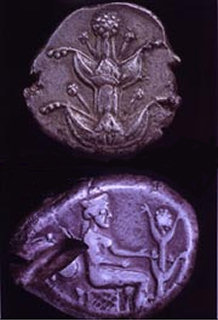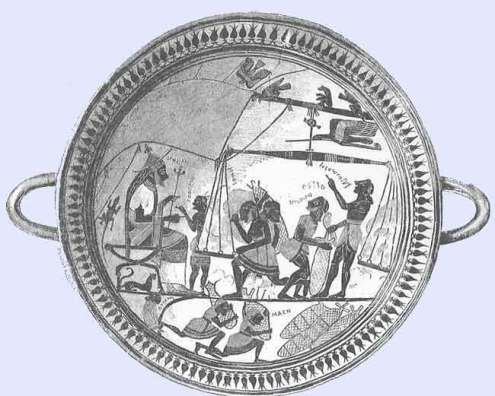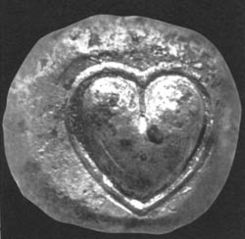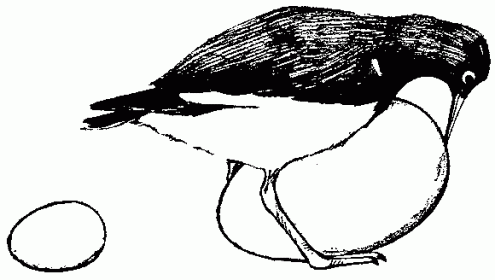Oliver, the Humanzee

In 1960, in the African nation of Zaire (now the Democratic Republic of Congo), a peculiar discovery was made. It was a young male chimpanzee with a strikingly humanoid face and the propensity for bipedal locomotion (a trait previously unobserved amongst chimpanzees). This bizarre animal found its way into the care of American animal trainers Frank and Janet Berger who dubbed their new pet Oliver.

Oliver exhibiting his characteristic upright stance. He was rarely seen walking on his knuckles.
Oliver showed a strong desire to adapt as many human affects as possible, including smoking cigars, shunning the company of other chimpanzees, and even making sexual overtures toward Janet. When put on display in the public eye, Oliver became a media sensation, and was widely believed to be some sort of missing link or human-chimpanzee hybrid. Genetic testing did in fact reveal that Oliver possessed forty-eight chromosomes, one more than is common in chimpanzees, and one less than is common in humans. In lieu of any further discussion of Oliver, I have included below the complete documentary produced by the Discovery Channel in 2006 exploring this strange creature and his unique story.
The Lost Panacea of Silphium
 Native to the ancient Greek colony of Cyrene (located in modern day Libya), Silphium (also known as laser) is an extinct plant that, in its heyday, was one of the most treasured medicinal resources of the ancient world. Employed by cultures all around the Mediterranean, Silphium was used as a spice, a cure-all medicinal remedy, a form of birth control, and an agent for pregnancy abortion. Famed scholars ranging from Pliny the Elder to Herodotus to Theophrastus all wrote of Silphium’s legendary potency. Despite its widespread popularity, Silphium allegedly refused to grow anywhere aside from Cyrene. The colony became so closely identified with the plant that it appears on the settlement’s coins.
Native to the ancient Greek colony of Cyrene (located in modern day Libya), Silphium (also known as laser) is an extinct plant that, in its heyday, was one of the most treasured medicinal resources of the ancient world. Employed by cultures all around the Mediterranean, Silphium was used as a spice, a cure-all medicinal remedy, a form of birth control, and an agent for pregnancy abortion. Famed scholars ranging from Pliny the Elder to Herodotus to Theophrastus all wrote of Silphium’s legendary potency. Despite its widespread popularity, Silphium allegedly refused to grow anywhere aside from Cyrene. The colony became so closely identified with the plant that it appears on the settlement’s coins.

Silphium, here seen on Cyrene's coins, was the colony's chief export. The plant was notoriously resistant to cultivation, and is believed to have been harvested to extinction within the first few centuries AD.
Silphium was so strongly desired by various ancient civilizations that it was, at times, valued above currency. With some Romans contending that the plant was a gift from the god Apollo, its extinction was considered a great tragedy. Pliny even wrote that the last known Silphium plant was given to the Roman Emperor Nero himself.

An artifact from the 6th century believed to depict King Arcesilaus II of Cyrene overseeing the weighing of Silphium.
The Egyptians shared the Romans’ veneration of the plant, associating its with human love and sexuality. The Egyptian glyph signifying the heart portion of the soul, in fact, may have been meant to picture the seed of the Silphium plant. This character, known to the Egyptians as Ib, is likely the origin of our modern heart symbol.

Here is an ancient Cyrene coin bearing the image of a Silphium seed. Its likeness both to the Egyptian Ib and to the modern heart symbol is striking.
While the world has been without Silphium and its powers for well over a millennium, our modern culture still bears its mark. Every time a love-dazed youth carves a heart into a tree or inserts a whimsical, heart-shaped emoticon into an online conversation, the plant that once commanded a king’s ransom is winking at us from the ghostly recesses of the Earth’s past. Like the Dodo bird that gave us an insult implying stupidity or the dinosaur that inhabits every child’s imagination, Silphium’s potency is strong enough to overcome the silencing power of extinction itself.
Some Further Reading:
Some information about Silphium’s possible use as birth control and an abortifacient
An article entitled “Abortion in the Ancient and Premodern World”
An article about ancient methods of measurement, including brief mention of Silphium from Cyrene
An essay addressing the five parts of the Egyptian soul, including Ib
Carlo Gesualdo, the Murderous Composer
Carlo Gesualdo (1566 – 1613), Prince of Venosa, was an Italian Renaissance nobleman and composer widely renowned amongst music aficionados for his compositions that were centuries ahead of their time. The beauty of his famed madrigals is eclipsed only by the savage ferocity with which he committed one of the most notorious acts of violence in the history of western music.

Gesualdo had long been acquainted with Donna Maria D’Avalos, his first cousin, but it wasn’t until the year 1586 that her beauty overwhelmed him and he took her hand in marriage. Several years into the marriage Donna Maria began an affair with the Duke of Andria that was well known to many, but not to Gesualdo. It took two years before news of the affair reached him, at which point he resolved to catch the lovers mid-tryst. In 1590 Gesualdo allegedly left on a hunting trip and, once the lovers were in each other’s arms, burst into the bed chamber and stabbed the two where they lay (some reports even alleging that Gesualdo forced the Duke to don the lady’s eveningwear before he slaughtered the emasculated interloper).
Far from keeping the violent affair out of the public eye, Gesulado strew the remains of his wife and the Duke in front of his Florentine manor for all to see. The murders, in fact, became fodder for the Renaissance equivalent of a media frenzy, inspiring a generation of tawdry and sensationalistic poetry. This publicity did little to put Gesualdo’s freedom in danger since noblemen of the day were immune from legal prosecution. He was, however, officially censured by the Vatican, which issued the claim that Gesualdo’s violent acts betrayed, “secular perversions and a lurid internal conflict setting decency and morality at the feet of carnal desires.” Despite the disapproving glare of the Vatican, Gesualdo went on to produce some of his most cherished composition in the 23 years between the murders and his death. These years were marred, however, by a debilitating depression that caused a desperate Gesualdo to go as far as ordering his servants to physically beat him on a daily basis.

The relationship between creative genius and the propensity for brutality is a common theme in the evaluation of historically significant artists. The self-mutilation of Vincent Van Gogh, the bloody suicide of Earnest Hemingway, the reckless, pistol-waving outbursts of Phil Specter. These well-known instances illustrate the savage potential associated with the sharpest creative minds. Authors Cecil Gray and Philip Heseltine summarized this coupling of notions well, in this case focusing specifically on musical creativity, in their book Carlo Gesualdo, Prince of Venosa, Musician and Murderer:
“But more particularly is there a definite connection between music and murder, although it may not be readily apparent. Not that many musicians have actually committed murders (apart from Gesualdo, one can only think of Salieri who, as everyone knows, poisoned Mozart); nor, strange to say, have many musicians been murdered themselves, except Mozart and Stradella. The connection between the two activities is much more subtle but nonetheless close. In the first place, the significant fact should be noted that the beginning of the decline of murder as an art dates from precisely the same period as the development of music as a personal expression, i.e., the beginning of the 17th century. In the middle ages music was more a craft than an art, because the emotions which we now express in music were then actually expressed in life. In these good old days one committed a murder if one felt like it, and thought no more about the matter; today we write an Elektra or a Cavalleria Rusticana instead, in order to work off our feelings. In definite relation to the increased difficulties attendant upon the practice of murder, music has become more and more sadistic. In place of inflicting the utmost pain on a single individual, we outrage the ears of thousands.”
Some Further Reading:
An entry from Reference.com about Gesualdo
An essay focusing on Gesualdo the murderer
An Inquiry Into Notable Historical Figures: Isabelle Eberhardt
When pondering eras past, is it deceptively easy to reduce an entire culture, time-period, or social movement to a simplified list of customs, events, and personalities. One of Irrational Geographic’s missions is to highlight moments and individuals that have the ability to jar us out of this facile interpretation of history. An exemplary specimen of this is the traveller, hedonist, writer, and all-around iconoclast Isabelle Eberhardt (1877 – 1904).

Growing up in Geneva during the final years of the 19th century, Eberhardt possessed the then unheard-of cultural advantages of having an intellectual, nihilist, former Orthodox priest for a father and an aristocrat with imperial familial connections for a mother. This combination of influences and resources, coupled with an endlessly inquisitive nature, gave her the wherewithal to embrace foreign cultures and languages, and the means with which to pursue these interests through study and travel.

Since women were afforded precious few rights in 19th century Switzerland, Eberhardt augmented her autonomy by dressing as and affecting the mannerisms of a man. This would allow her freedom hitherto unknown to women when she was brought by her mother first to other parts of Europe, and later to northern Africa. Eberhardt’s father encouraged her cross-dressing, and further aided her personal growth by teaching her six languages, cultivating in her an interest in metaphysics, and introducing her to Islam. Eberhardt’s life trajectory was cemented when her family relocated to Algeria and fell in with Arab anti-imperialists.

Upon the death of her mother, Eberhardt was finally afforded the freedom to pursue her passions on her own terms. As she herself put it, “The farther behind I leave the past, the closer I am to forging my own…” Following the death of her father two years later, Eberhardt fully embraced the nomadic lifestyle of Sahara-dwelling Arabs. Her promiscuous tendencies made it well-known that she was biologically a woman, but the Arab community accepted her as a man. She also indulged in the use of drugs and alcohol, despite the fact that these endeavors were prohibited by Saharan custom. In the words of one of Eberhardt’s friends, “She drank more than a Legionnaire, smoked more kif than a hashish addict, and made love for the love of making love.” This highlights the contradictory nature of the hybrid identity that Eberhardt managed to establish.

Despite the apparent ambiguity of her cultural allegiances, Eberhardt was spiritually committed to, and fully accepted by, the secretive Sufi sect (even becoming a close friend of the sect’s spiritual leader), which seemed to turn a blind eye to her decadent lifestyle. Eberhardt also managed to marry and Arab soldier named Slimene Ehnni, who apparently tolerated her notorious promiscuity. Herein lies the intriguing mystery of Isabelle Eberhardt. She was a European-born white woman who lived freely in the Arab world as a man (assuming the masculine name Si Mahmoud Essadi), openly using drugs and alcohol while a devoted member of a temperant sect, and maintaing a marriage with an Arab man while still freely exploring her sexuality. She was a woman of contradictions who redefined the world in which she lived.

It seems fitting, then, that even in death she was an iconoclast. Eberhardt once wrote that, “Death does not frighten me, but dying obscurely and above all uselessly does.” The universe was seemingly ignorant of, or humorously invested in, this sentiment when, on October 1 of 1904, the 27-year-old Eberhardt, while recovering form a bout of malaria, perished in a flash flood in the Ain Sefra municipality of Algeria. This death could not, it seems, have been any more obscure or useless.

While relatively unknown during her lifetime, Eberhardt’s writings have received some posthumous attention. Several journals and one novel, penned by Eberhardt during her travels, give contemporary readers a glimpse into the unique life of a cross-dressing, hedonistic, European woman living happily in the orthodox climate of turn-of-the-century northern Africa. Several essays, linked below, explore many intriguing facets of Eberhardt’s life and adventures.
Some Further Reading:
An interesting article exploring the unconventional nature of her life
A site that discusses Eberhardt’s writings
The Pitfalls of Supernormal Stimuli
“…(supernormal stimulus) refers to a paradoxical effect whereby animals show greater responsiveness to stimuli that differ substantially from the “natural” stimulus.”
– J.E.R. Staddon, Behavioral Psychologist
I recently learned of the writings of Dutch ethologist Nikolaas Tinbergen (1907-1988), who performed some fascinating experiments on birds, specifically oystercatchers.

Shorebirds found all across the globe, oystercatchers possess a hard-wired trait that caught Tinbergen’s attention. After laying several eggs, female oystercatchers are faced with the choice of which egg to brood atop, and thus incubate the enclosed embryo until its hatching. Since larger eggs are more likely to produce healthy chicks, these birds are programmed to select their largest eggs for brooding. This tendency produces very odd results, however, when it is exposed to supernormal stimuli. In this case, Tinbergen placed the much larger eggs of a totally different species of bird along side the oystercatchers’ eggs. Surprisingly, the oystercatchers hopped right atop these absurdly large eggs, ignoring their own.

Here is former Food and Drug Administration Commissioner David A. Kessler’s explanation of this counterintuitive behavior:
“From the standpoint of evolution, a bird’s preference for a larger egg over a smaller one makes sense. Smaller eggs are more likely to be nonviable, so birds that consistently choose them would not have been likely to survive as a species. Their preference for a giant egg is a logical extension of a preference for the egg that seems most likely to be viable.”
The power of the supernormal stimulus of egg size to hijack the oystercatchers’ ingrained survival mechanisms is strong enough to cause these birds to cuckold themselves, expending precious time and energy to bring another bird’s child into the world. While this effect is curious when observed among birds, its results are more startling when applied to humans. An oft-cited example of this is the contentious issue of the portrayal and attractiveness of female bodies. For example, throughout history many women have had their bodies altered to make their breast bigger or appear to be bigger, whether through body-molding clothing or, more recently, surgery and photo editing.

Venus of Willendorf is a limestone carving of a woman’s body discovered in Lower Austria. It is believed to date from 24,000 BCE – 22,000 BCE. Her breasts are swollen to absurd proportions.
The Venus of Willendorf carving shows that the issue of male attraction to exaggerated, unnatural female forms is nothing new. University of Cambridge archaeologist Paul Mellars observes that, “…(Venus of Willendorf) could be seen as bordering on the pornographic.” This is an example of how male attraction to breasts, although having originally coevolved with actual female breasts, can be triggered by portrayals of exaggerated and unnatural breasts.
Another illustration of how supernormal stimuli can kidnap ingrained human desires and redirect them toward artificial ends can be found on the menu of any fast food restaurant.

This chart compares the calories and fat contained in hamburgers served at some leading fast food chains
When competing for survival, pre-agricultural humans benefited greatly from eating as much animal fat as they could get their hands on due to its rich caloric content. As a result, the human tongue and brain grew to find fat quite palatable. In modern society it is much easier to gain access to fatty foods, but the tongue and brain can still be motivated by a primal desire to eat as much fat as possible, as if stockpiling calories in the face of potential periods of famine. In their book Understanding Nutrition, nutritionists Elli Whitney and Sharon Randy Rolfes claim that a healthy adult should consume 45 to 75 grams of fat each day. Many of the hamburgers on the above chart, however, exceed this daily amount despite the fact that they are meant to comprise just one meal (foods containing wildly inflated amounts of fat, salt, sugar, and so on are dubbed “hyperpalatable” by food scientists).
The overwhelming popularity of these restaurants (McDonald’s having famously served “billions and billions”) demonstrates how a human drive that originally aided survival now leads many to consume significantly more fat than their bodies require, potentially to the detriment of their health. These chain restaurants, however, are not fully to blame for selling such hyperpalatable food. As W. Philip T. James of the International Obesity Task Force points out, “It is little wonder that food manufacturers, responding to taste panels and sales returns, have focused, particularly in the last two decades, on providing this evolutionarily rare but highly prized sensory mix as a routine in an increasingly varied number of foods made for convenient consumption.”
There are many more examples of supernormal stimuli leading people to self-destructive behavior, ranging from drug addiction (certain drugs, such as cocaine, stimulate a massive release of dopamine in the brain, whereas dopamine is released in much smaller quantities under natural circumstances) to video game enthusiasts literally starving to death after playing World of Warcraft for days on end without interruption. The conclusion to be drawn is that, in order to enjoy the spoils of modern life healthfully in the face of ubiquitous supernormal stimuli, a certain resistance to one’s own chemical drives is neccessary. This is no easy task, however, since the brain is literally built to perceive the satisfaction of these desires as necessary for survival.
Some Further Reading:
A very interesting article about how supernormal stimulus is used in product marketing